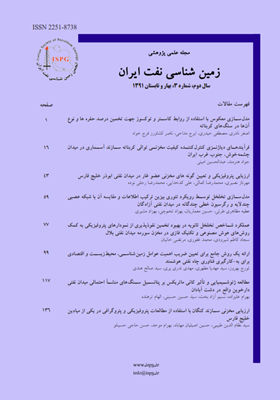فرایند های دیاژنزی کنترل کننده کیفیت مخزنی توالی کربناته سازند آسماری در میدان چشمه خوش ،جنوب غرب ایران
محورهای موضوعی :جواد هنرمند 1 , عبدالحسین امینی 2
1 - پژوهشگاه صنعت نفت
2 - دانشگاه تهران
کلید واژه: دیاژنز کیفیت مخزنی آسماری ومیدان نفتی چشمه خوش ,
چکیده مقاله :
سازند آسماری به سن الیگو-میوسن در میدان نفتی چشمه خوش از توالی مخلوط کربناته –آواری تشکیل شده است .توالی کربناته این سازند ناهمگونی های عمودی شدید ی نشان می دهد که ناشی از تاریخچه دیاژنزی پیچیده آن می باشد .در این مطالعه که با هدف بررسی تاثیر فرایند های دیاژنزی رکیفیت مخزنی توالی کربناته این سازند انجام شده ،نمونه های مغزه ومقاطع نازک از نظر ویژگی های رسوب شناسی ودیاژنزی مورد مطالعه قرار گرفت .به منظور شناخت دقیق تر محصولات دیاژنزی ،از میکروسکوپ الکترونی وکاتدولومینسانس استفاده گردید .داده های آنالیز مغزه (تخلخل وتراوایی9ونمودار های پترو فیزیکی (تخلخل واشباع نفت )سازند اسماری نیز جهت بررسی خواص مخزنی آن بکار گرفته شد . مطالعات دیاژنزی ومقایسه آن با داده های پترو فیزیکی نشان داد که دولومیتی شدن فسیمانی شدن (سیمان های کلسیت ،انیدریت وسلستیت )،تراکم وانحلال مهم ترین پدید ه های دیاژنزی کنتر ل کننده تخلخل وتراوائی در این سازند می باشند.بر مبنای توزیع عمودی پدید های دیاژنزی وخواص مخزنی ،زون های دیاژنزی در سازند آسماری معرفی شد .زون های دولومیتی با بلور های متوسط که دارای آثار تراکم وسیمان انیدریتی خیلی کم هستند از بالاترین مقادیر تخلخل وتراوائی برخوردارند0زون های( 27،23و30).در حالی که عملکرد شدید تراکم وتشکیل سیمان های انیریت وسلستیت در برخی افق ها به شدت خواص مخزنی را کاهش داده است (زون های 20،3 و17) اما سیمانی شدن وتراکم محدود ووجود تخلخل بین دانه ای وانحلالی در بخش هایی از توالی آهکی سازند آسماری خواص مخزنی را بهبود بخشده است (زون های 31و31). با توجه به اینکه خواص مخزنی سازند آسماری در این میدان به شدت متاثر از فرایند های دیاژنزی است لذا مدل سازی استاتیک این مخزن وتعیین روند توزیع پارامتر های مخزنی مستلزم مطالعات دیاژنزی وتعیین زون های دیاژنزی در گستره میدان خواهد بود .
The Oligo-miocence Asmari Formation in the Cheshmeh Kush Oil Field consists of a mixed carbonate-siliciclastic succession. The carbonate intervals of the Formation display a high degree of vertical heterogeneity created by a complex diagenetic history. This study is aimed to investigate the effect of diagenetic events on reservoir quality of carbonate intervals of the Asmari Formation. Core samples and thin sections were studied from sedimentological and diagenetic point of view. Results from cathodoluminesence and scanning electron microscopy were used to investigate diagenetic features in details. Core analysis data (porosity and permeability) and wire-line logs (porosity and oil saturation values) from studied interval were used in order to examine reservoir properties. Diagenetic studies and their comparison with petrophysical data demonstrated that dolomitization, cementation (calcite, anhydrite and celestite cements), compaction and dissolution are the most important diagenetic events affecting porosity and permeability of the reservoir. Based on vertical distribution of diagenetic features and reservoir characteristics, diagenetic zones (DZ) of the carbonate succession were introduced. Medium crystalline dolostones with sparse compaction features and limited anhydrite cement (DZ-23, 27 and 30) comprise the highest value of porosity and permeability. Whereas intense mechanical and chemical compaction and evaporate (anhydrite and celestite) cementation in some dolomitic intervals have thoroughly reduced reservoir quality (DZ-12, 11 and 24). Compaction and calcite cementation (coarse spary, equant and poikilotopic types) in some limestone intervals damaged reservoir properties and created non-reservoir intervals (DZ-3, 20 and 17). In contrast, high value of interparticle and dissolution porosities along with minor compaction and cementation effects has improved reservoir properties of the Asmari limestones (DZ-31 and 32). This study shows that the reservoir characteristics of the Asmari Formation in the studied field are dominantly affected by diagenetic events and therefore diagenetic studies and determination of diagenetic zones in field-scale are the most important part in static reservoir modeling and

